Robust H∞ Load Frequency Control of Power Systems Considering Intermittent Characteristics of Demand-Side Resources
Abstract
1. Introduction
- The intermittent characteristics of DSRs is described in this paper, and a novel intermittent controller for DSRs is designed to overcome the problems caused by intermittent characteristics.
- A coordination LFC system between DSRs and generation-side resources in primary frequency control is constructed.
- A rigorous stability proof and the robust performance analysis is provided for the coordinated LFC system.
2. The Model of LFC System Considering Intermittent Characteristics of DSRs
2.1. Intermittent Characteristics of DSRs
2.2. Intermittent Control Method for Intermittent Characteristics of DSRs
2.3. Open-Loop LFC System Model
2.4. Closed-Loop LFC System Model and Robust Performance
3. Main Result
3.1. Preliminaries
3.2. The Stability Analysis of the LFC System
- (a)
- (b)
- ,
- (c)
- ,
- (d)
- (e)
- (f)
- ,
3.3. The Performance Analysis of the LFC System
4. Case Studies
4.1. The Open-Loop LFC System
4.2. The Close-Loop LFC System
4.2.1. Only Using Generation-Side Resources in LFC System
4.2.2. Using DSRs and Generation-Side Resources in LFC System
- As can be seen from Section 2.1 that parameters T and are affected by the intermittent characteristics of DSRs. In fact, these two parameters are fixed when the DSRs is identified. We can find some corresponding data from [7].
- For DSRs, when they participate in primary frequency control, they can only monitor the local frequency deviation of the system. They cannot obtain the other state such as the tie line power deviation andthe mechanical power deviation , etc. So parameter K should be a sparse matrix like the transposition of input matrix .
5. Conclusions
- The intermittent characteristic of DSRs varies from user to user, which can affect the frequency performance of the power system.
- The intermittent control method can help the power grid adapt to the intermittent characteristics of DSRs.
- Reasonable coordination of generation-side resources and DSRs in frequency control can ensure the robustness of the LFC system and reduce the regulation pressure of the power generation-side.
Author Contributions
Funding
Conflicts of Interest
Appendix A
Appendix B
References
- Sun, Y.; Wang, Y.; Wei, Z.; Sun, G.; Wu, X. Robust H∞ load frequency control of multi-area power system with time delay: A sliding mode control approach. IEEE/CAA J. Autom. Sin. 2017, 5, 610–617. [Google Scholar] [CrossRef]
- Bao, Y.Q.; Li, Y.; Hong, Y.Y.; Wang, B. Design of a hybrid hierarchical demand response control scheme for the frequency control. IET Gener. Transm. Distrib. 2015, 9, 2303–2310. [Google Scholar] [CrossRef]
- Ming, N.; Qian, C.; Manli, L.; Qi, W.; Yi, T. A Frequency Control Model for Cyber Physical Power System Considering Demand Response Strategy. Energy Procedia 2018, 145, 38–43. [Google Scholar] [CrossRef]
- Anwar, M.B.; Qazi, H.W.; Burke, D.J.; O’Malley, M. Harnessing the Flexibility of Demand-side Resources. IEEE Trans. Smart Grid 2018, 10, 4151–4163. [Google Scholar] [CrossRef]
- Cui, H.; Li, F.; Hu, Q.; Bai, L.; Fang, X. Day-ahead coordinated operation of utility-scale electricity and natural gas networks considering demand response based virtual power plants. Appl. Energy 2016, 176, 183–195. [Google Scholar] [CrossRef]
- Pourmousavi, S.A.; Nehrir, M.H. Real-time central demand response for primary frequency regulation in microgrids. IEEE Trans. Smart Grid 2012, 3, 1988–1996. [Google Scholar] [CrossRef]
- Molina-Garcia, A.; Bouffard, F.; Kirschen, D.S. Decentralized demand-side contribution to primary frequency control. IEEE Trans. Power Syst. 2010, 26, 411–419. [Google Scholar] [CrossRef]
- Molina-García, A.; Munoz-Benavente, I.; Hansen, A.D.; Gómez-Lázaro, E. Demand-side contribution to primary frequency control with wind farm auxiliary control. Trans. Power Syst. 2014, 29, 2391–2399. [Google Scholar] [CrossRef]
- Khooban, M.H.; Niknam, T.; Blaabjerg, F.; Dragičević, T. A new load frequency control strategy for micro-grids with considering electrical vehicles. Electr. Power Syst. Res. 2017, 143, 585–598. [Google Scholar] [CrossRef]
- Wang, Y.; Xu, Y.; Tang, Y. Distributed aggregation control of grid-interactive smart buildings for power system frequency support. Appl. Energy 2019, 251, 113371. [Google Scholar] [CrossRef]
- Zaman, M.; Bukhari, S.; Haider, R.; Hazazi, K.; Kim, C.; Ashraf, H. Demand Response Augmented Control with Load Restore Capabilities for Frequency Regulation of an RES-Integrated Power System. In Proceedings of the 2018 International Conference on Electrical Engineering (ICEE), Lahore, Pakistan, 15–16 February 2018; pp. 1–5. [Google Scholar]
- Samarakoon, K.; Ekanayake, J.; Jenkins, N. Investigation of domestic load control to provide primary frequency response using smart meters. IEEE Trans. Smart Grid 2011, 3, 282–292. [Google Scholar] [CrossRef]
- Delavari, A.; Kamwa, I. Sparse and resilient hierarchical direct load control for primary frequency response improvement and inter-area oscillations damping. IEEE Trans. Power Syst. 2018, 33, 5309–5318. [Google Scholar] [CrossRef]
- Shiltz, D.J.; Baros, S.; Cvetković, M.; Annaswamy, A.M. Integration of automatic generation control and demand response via a dynamic regulation market mechanism. IEEE Trans. Control Syst. Technol. 2017, 27, 631–646. [Google Scholar] [CrossRef]
- Fini, M.H.; Golshan, M.E.H. Frequency control using loads and generators capacity in power systems with a high penetration of renewables. Electr. Power Syst. Res. 2019, 166, 43–51. [Google Scholar] [CrossRef]
- Pourmousavi, S.A.; Nehrir, M.H. Introducing dynamic demand response in the LFC model. IEEE Trans. Power Syst. 2014, 29, 1562–1572. [Google Scholar] [CrossRef]
- Pourmousavi, S.A.; Behrangrad, M.; Nehrir, M.H.; Ardakani, A.J. LFC model for multi-area power systems considering dynamic demand response. In Proceedings of the 2016 IEEE/PES Transmission and Distribution Conference and Exposition (T&D), Dallas, TX, USA, 3–5 May 2016; pp. 1–5. [Google Scholar]
- Tang, Y.; Li, F.; Chen, Q.; Li, M.; Wang, Q.; Ni, M.; Chen, G. Frequency prediction method considering demand response aggregate characteristics and control effects. Appl. Energy 2018, 229, 936–944. [Google Scholar] [CrossRef]
- Xu, J.; Liao, S.; Sun, Y.; Ma, X.Y.; Gao, W.; Li, X.; Gu, J.; Dong, J.; Zhou, M. An isolated industrial power system driven by wind-coal power for aluminum productions: A case study of frequency control. IEEE Trans. Power Syst. 2014, 30, 471–483. [Google Scholar] [CrossRef]
- Kirchem, D.; Lynch, M.Á.; Bertsch, V.; Casey, E. Modelling demand response with process models and energy systems models: Potential applications for wastewater treatment within the energy-water nexus. Appl. Energy 2020, 260, 114321. [Google Scholar] [CrossRef]
- Han, S.; Han, S.; Sezaki, K. Development of an optimal vehicle-to-grid aggregator for frequency regulation. IEEE Trans. Smart Grid 2010, 1, 65–72. [Google Scholar]
- Abrishambaf, O.; Faria, P.; Vale, Z. Application of an optimization-based curtailment service provider in real-time simulation. Energy Inf. 2018, 1, 3. [Google Scholar] [CrossRef]
- Qazi, H.W.; Flynn, D. Synergetic frequency response from multiple flexible loads. Electr. Power Syst. Res. 2017, 145, 185–196. [Google Scholar] [CrossRef]
- Liu, H.; Huang, K.; Wang, N.; Qi, J.; Wu, Q.; Ma, S.; Li, C. Optimal dispatch for participation of electric vehicles in frequency regulation based on area control error and area regulation requirement. Appl. Energy 2019, 240, 46–55. [Google Scholar] [CrossRef]
- Muñoz-Benavente, I.; Hansen, A.D.; Gómez-Lázaro, E.; García-Sánchez, T.; Fernández-Guillamón, A.; Molina-García, Á. Impact of combined demand-response and wind power plant participation in frequency control for multi-area power systems. Energies 2019, 12, 1687. [Google Scholar] [CrossRef]
- Muñoz-Benavente, I.; Gómez-Lázaro, E.; García-Sánchez, T.; Vigueras-Rodríguez, A.; Molina-García, A. Implementation and assessment of a decentralized load frequency control: Application to power systems with high wind energy penetration. Energies 2017, 10, 151. [Google Scholar] [CrossRef]
- Loram, I.D.; Gollee, H.; Lakie, M.; Gawthrop, P.J. Human control of an inverted pendulum: is continuous control necessary? Is intermittent control effective? Is intermittent control physiological? J. Physiol. 2011, 589, 307–324. [Google Scholar] [CrossRef] [PubMed]
- Xia, W.; Cao, J. Pinning synchronization of delayed dynamical networks via periodically intermittent control. Chaos Interdisciplin. J. Nonlinear Sci. 2009, 19, 013120. [Google Scholar] [CrossRef]
- Ruan, S.; Filfil, R.S. Dynamics of a two-neuron system with discrete and distributed delays. Physica D Nonlinear Phenomena 2004, 191, 323–342. [Google Scholar] [CrossRef]
- Yuan, K.; Cao, J.; Li, H.X. Robust stability of switched Cohen–Grossberg neural networks with mixed time-varying delays. IEEE Trans. Syst. Man Cybern. Part B Cybern. 2006, 36, 1356–1363. [Google Scholar] [CrossRef]
- Żochowski, M. Intermittent dynamical control. Physica D Nonlinear Phenomena 2000, 145, 181–190. [Google Scholar] [CrossRef]
- Liu, Z.W.; Yu, X.; Guan, Z.H.; Hu, B.; Li, C. Pulse-modulated intermittent control in consensus of multiagent systems. IEEE Trans. Syst. Man Cybern. Syst. 2016, 47, 783–793. [Google Scholar] [CrossRef]
- Li, C.; Feng, G.; Liao, X. Stabilization of nonlinear systems via periodically intermittent control. IEEE Trans. Circuits Syst. Express Briefs 2007, 54, 1019–1023. [Google Scholar]
- Li, C.; Liao, X.; Huang, T. Exponential stabilization of chaotic systems with delay by periodically intermittent control. Chaos: Interdisciplin. J. Nonlinear Sci. 2007, 17, 013103. [Google Scholar] [CrossRef] [PubMed]
- Cao, J.; Yuan, K.; Ho, D.W.; Lam, J. Global point dissipativity of neural networks with mixed time-varying delays. Chaos Interdisciplin. J. Nonlinear Sci. 2006, 16, 013105. [Google Scholar] [CrossRef]
- Chen, C.; Zhang, K.; Yuan, K.; Zhu, L.; Qian, M. Novel detection scheme design considering cyber attacks on load frequency control. IEEE Trans. Ind. Inf. 2017, 14, 1932–1941. [Google Scholar] [CrossRef]
- Carvalho, J.P.; Shafie-khah, M.; Osório, G.; Rokrok, E.; Catalão, J.P. Multi-Agent System for Renewable Based Microgrid Restoration. In Proceedings of the 2018 International Conference on Smart Energy Systems and Technologies (SEST), Sevilla, Spain, 10–12 September 2018; pp. 1–6. [Google Scholar]
- Halanay, A. Differential Equations: Stability, Oscillations, Time Lags, 1st ed.; Academic Press: New York, NY, USA, 1966; pp. 611–615. [Google Scholar]
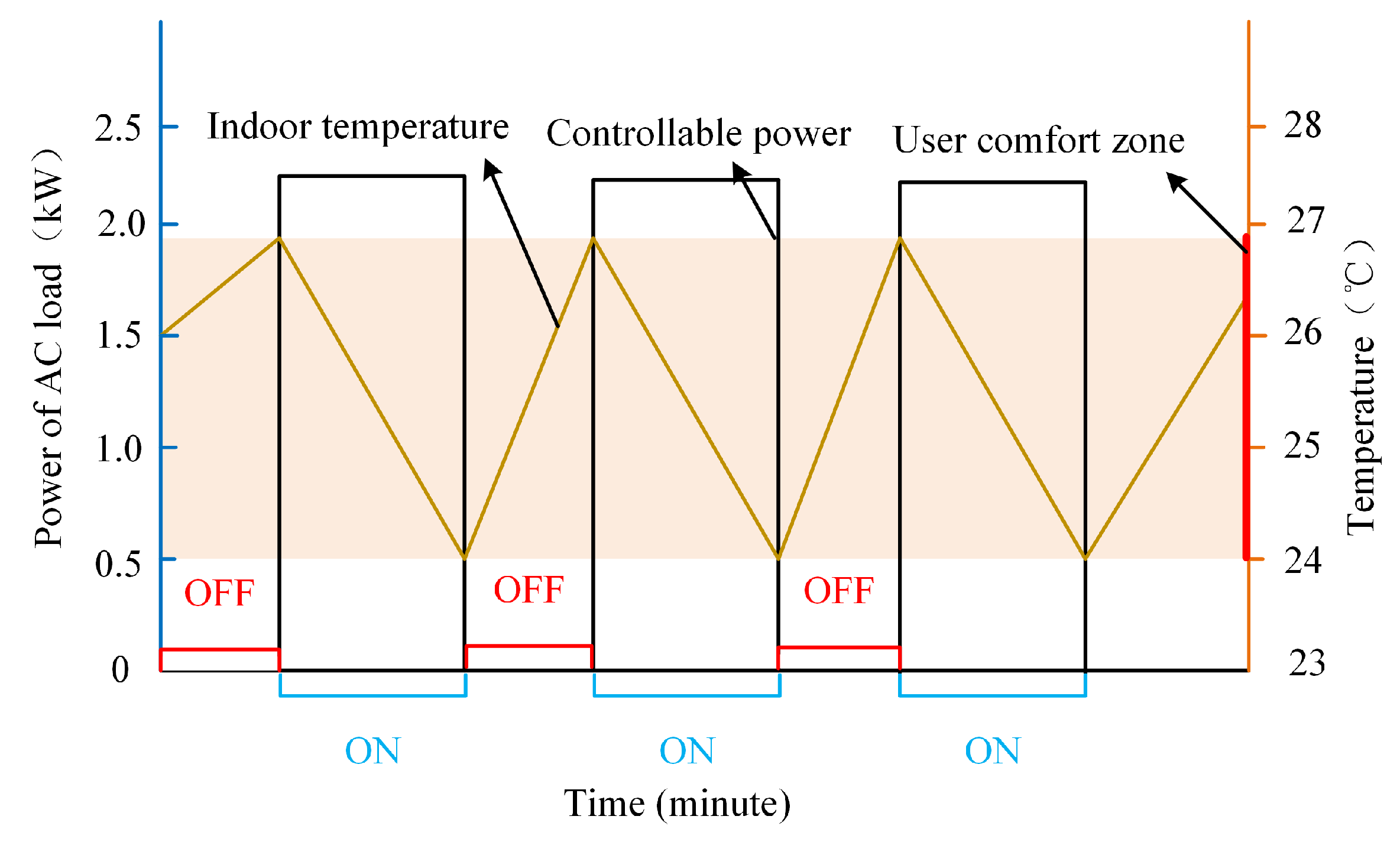

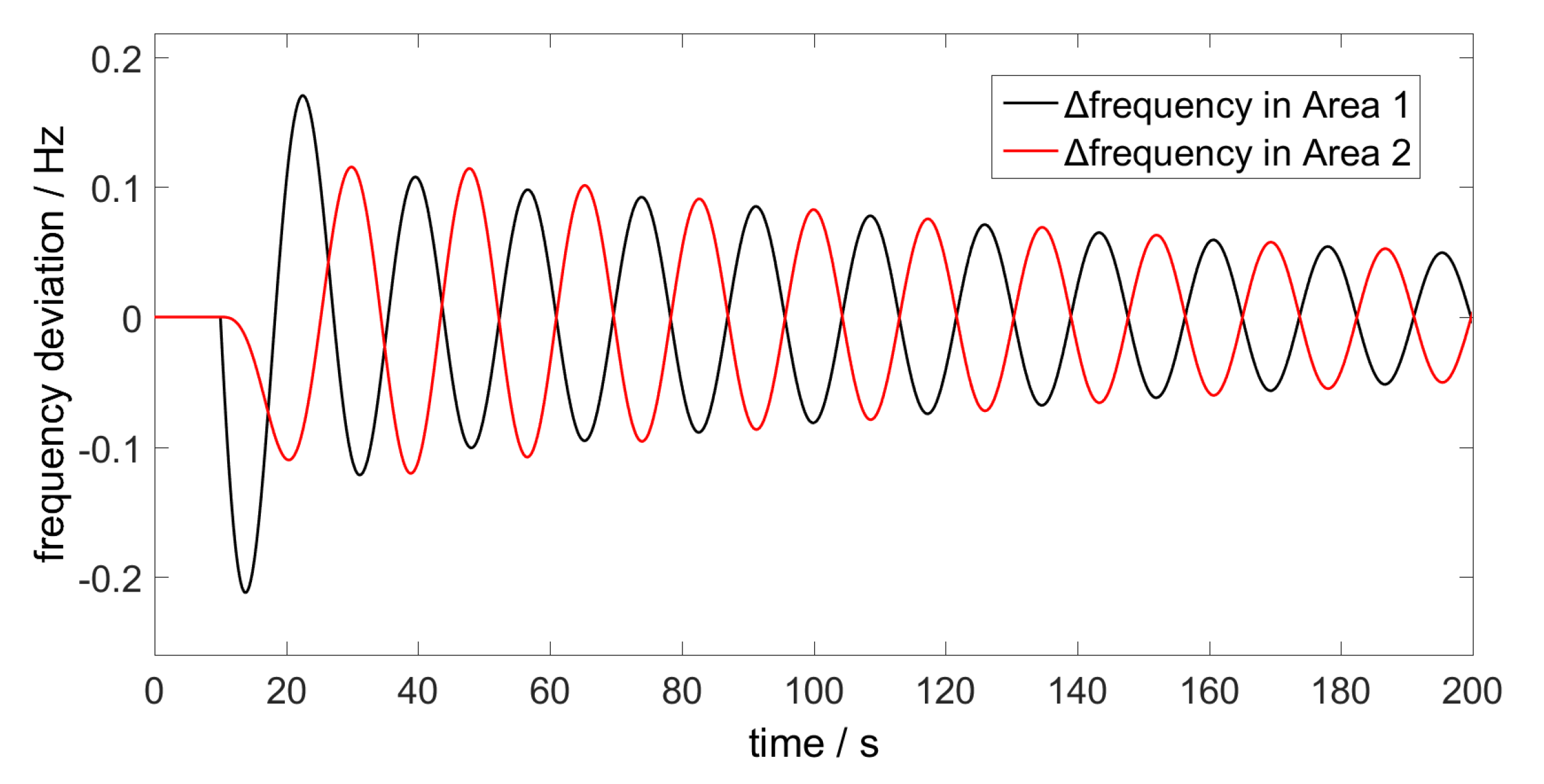
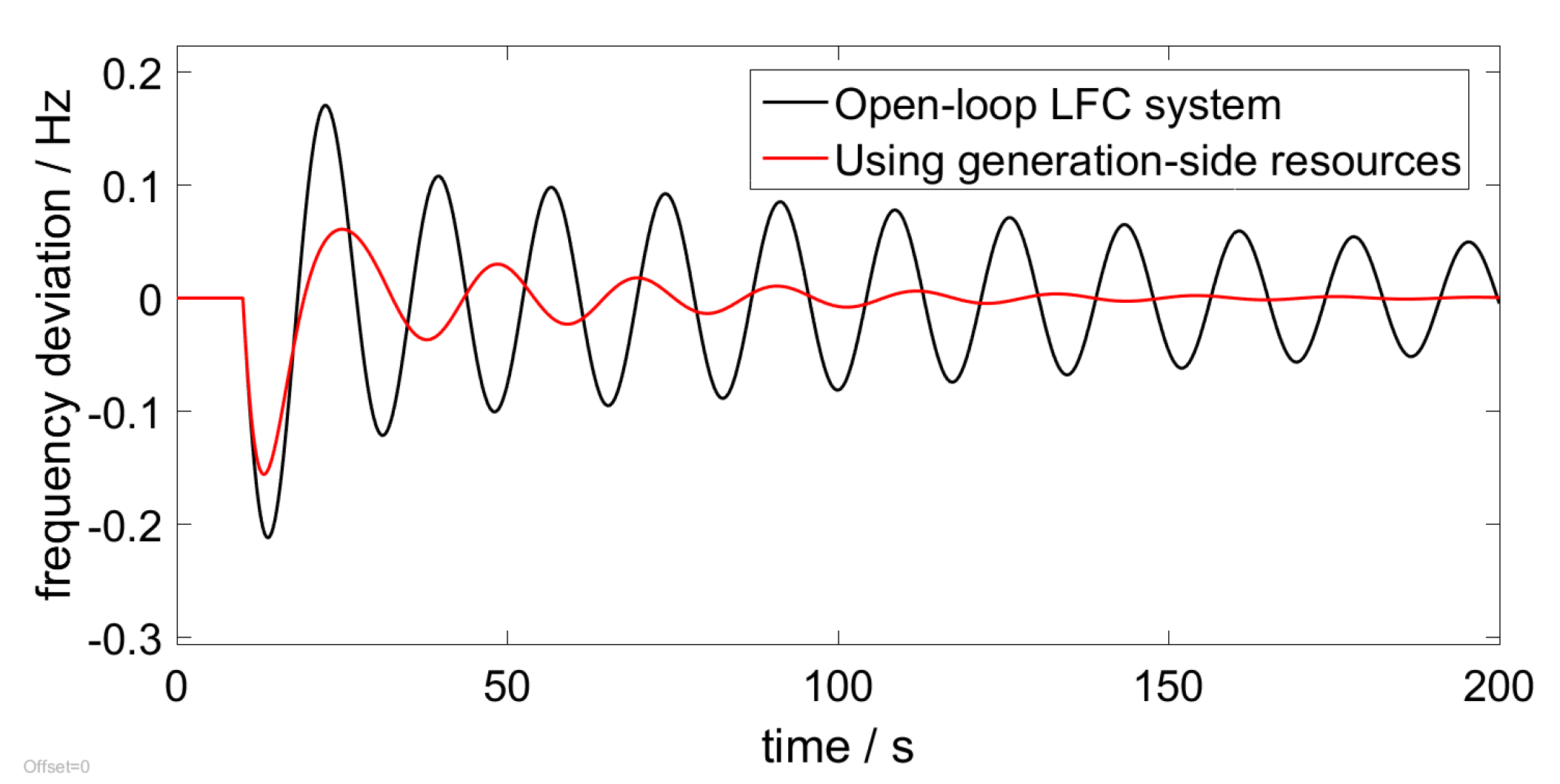
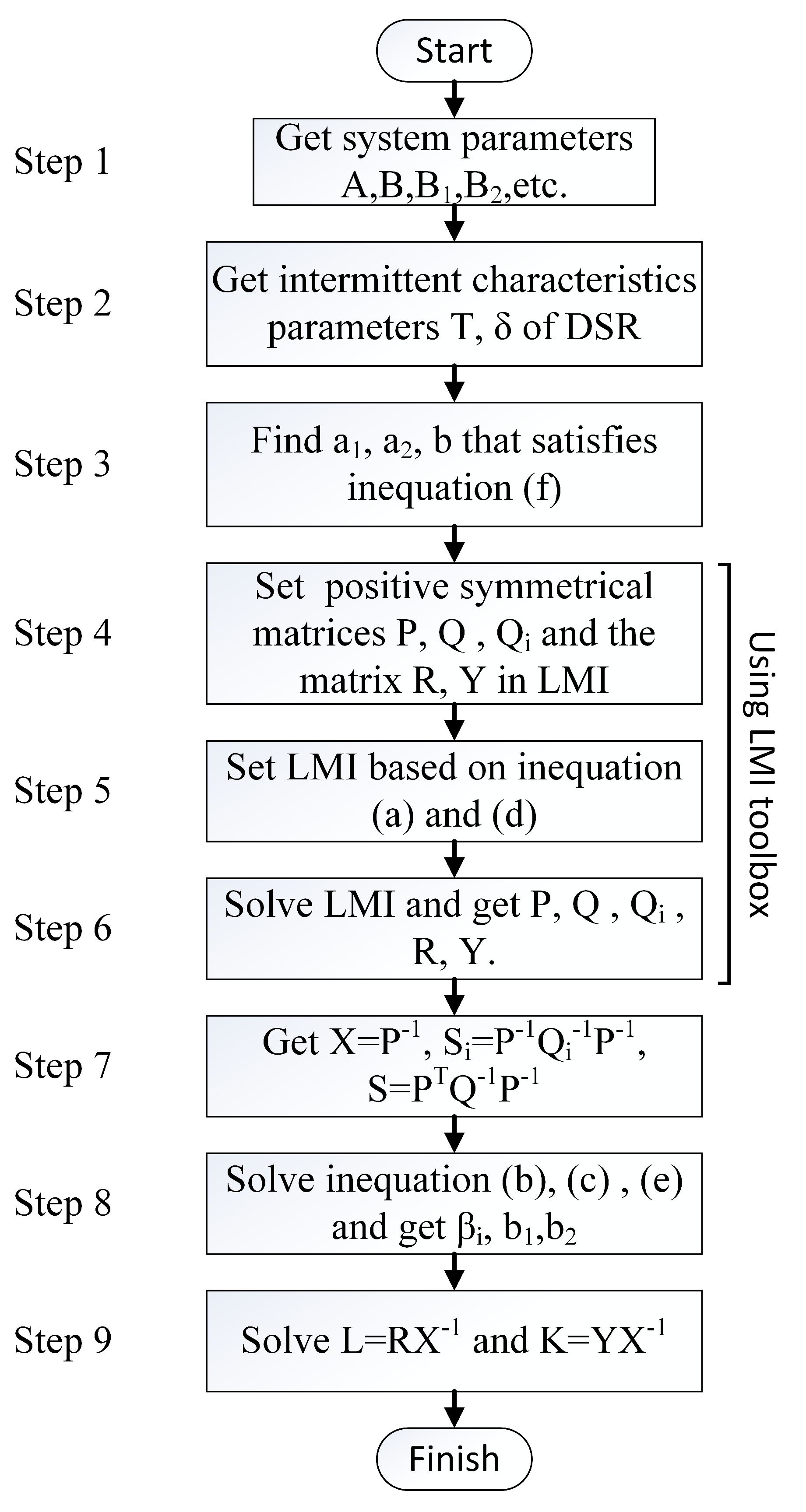
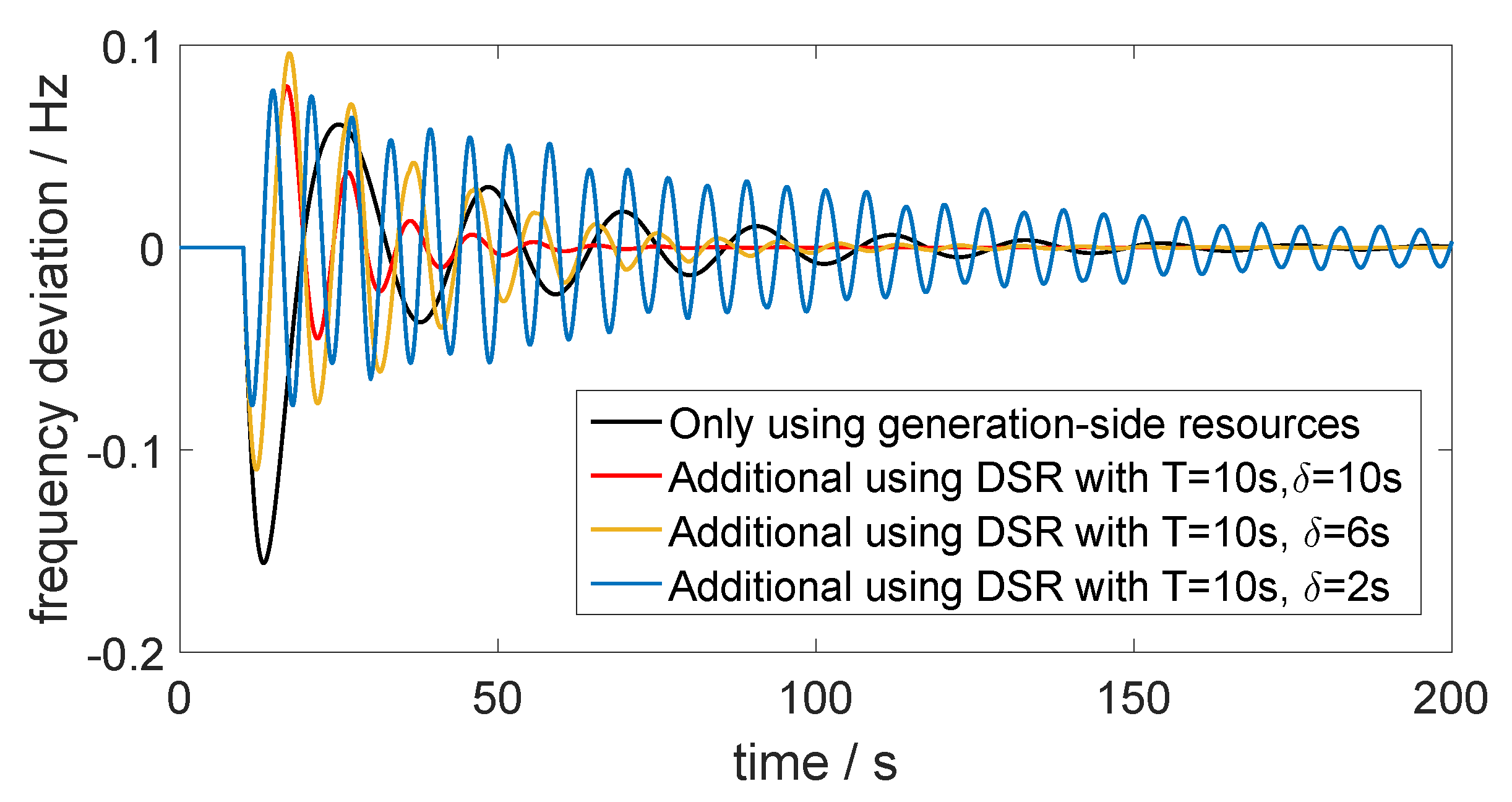
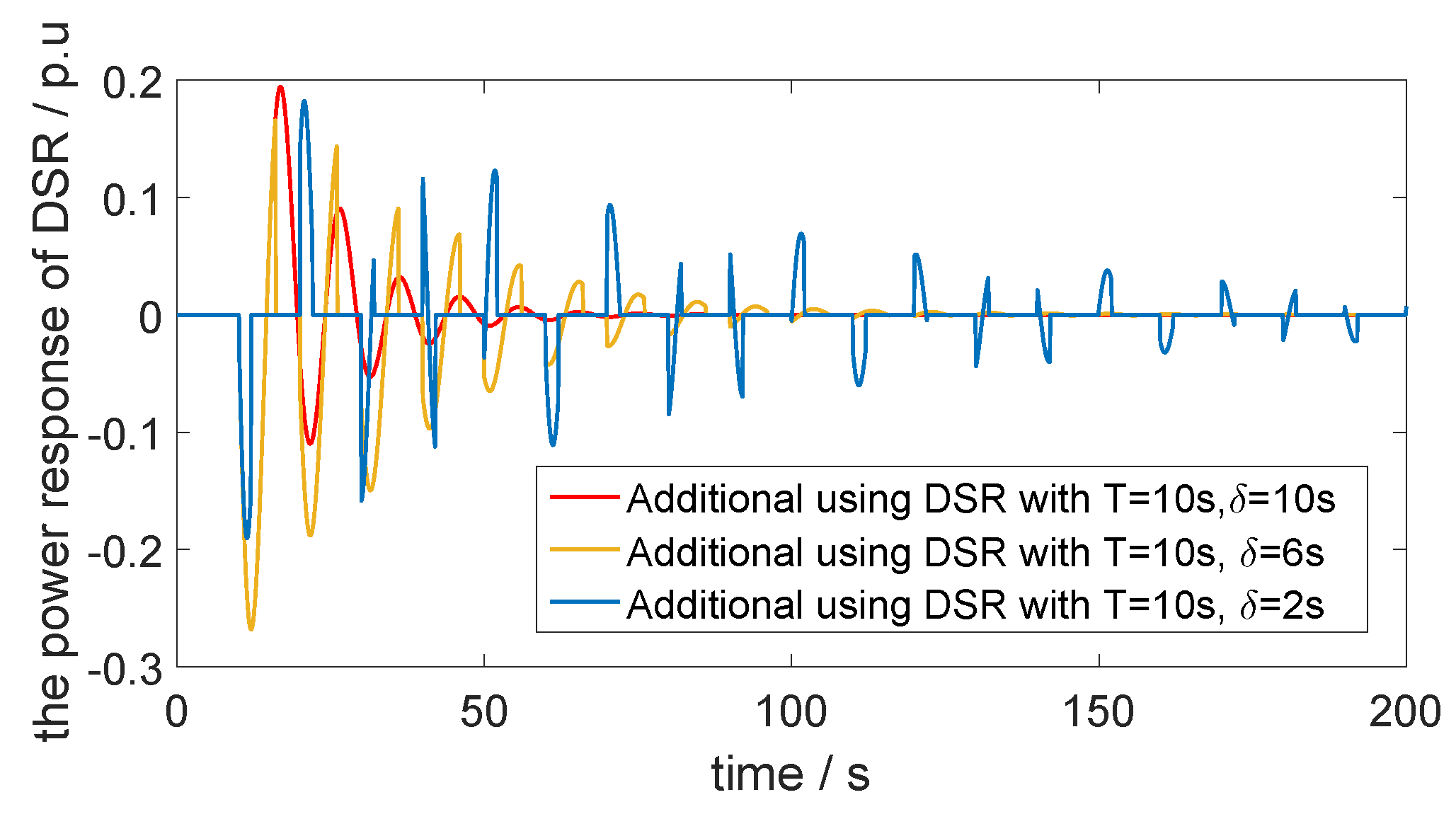
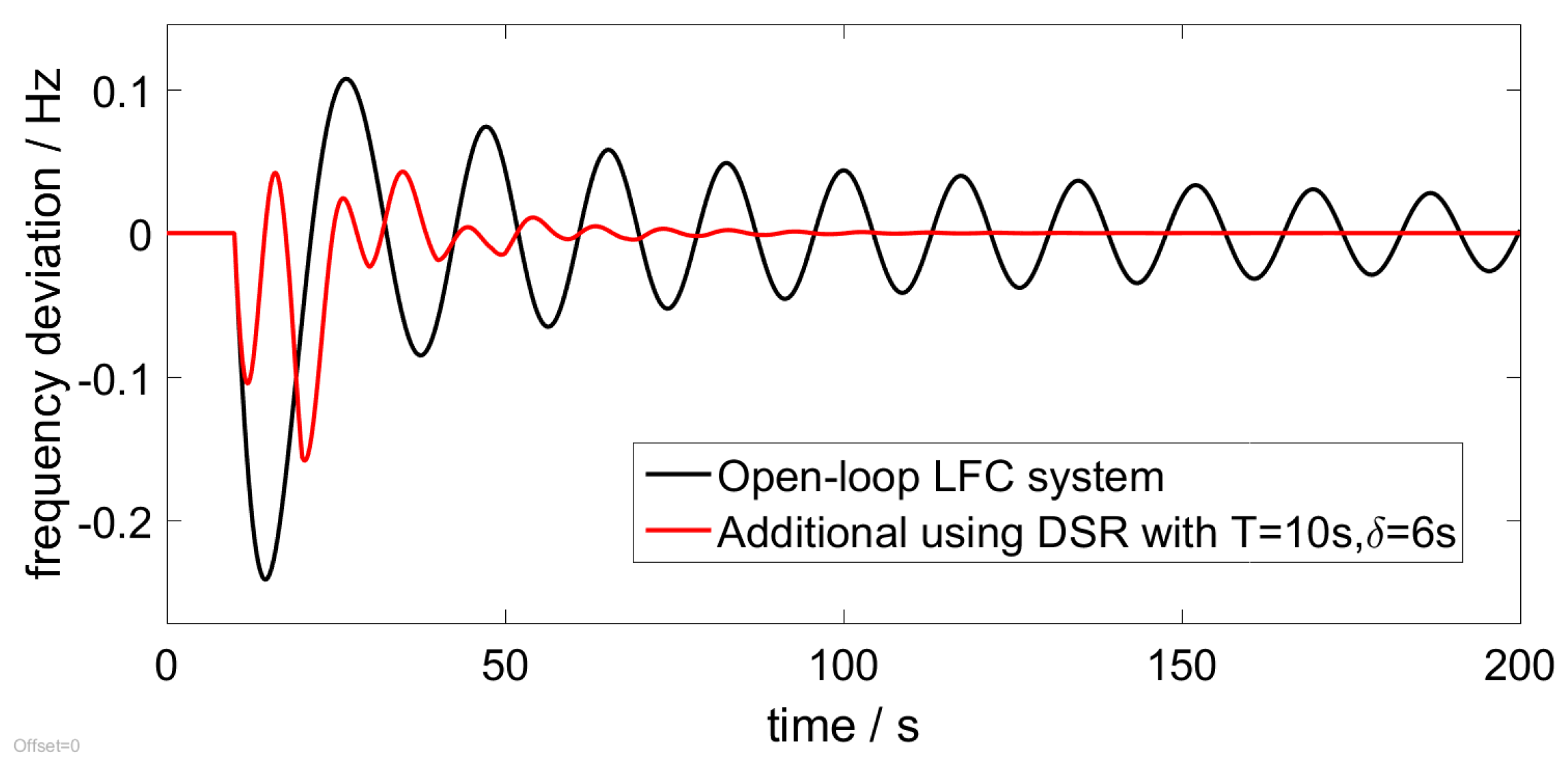

| Area | ||||||||
|---|---|---|---|---|---|---|---|---|
| 1 | 0.15 | 0.31 | 1 | 10 | 2 | 1 | 0.5 | 0.1 |
| 2 | 0.2 | 0.3 | 1 | 10 | 2 | 1 | 0.5 | 0.1 |
© 2020 by the authors. Licensee MDPI, Basel, Switzerland. This article is an open access article distributed under the terms and conditions of the Creative Commons Attribution (CC BY) license (http://creativecommons.org/licenses/by/4.0/).
Share and Cite
Yuan, K.; Ding, Z.; Li, Y.; Huang, M.; Zhang, K. Robust H∞ Load Frequency Control of Power Systems Considering Intermittent Characteristics of Demand-Side Resources. Electronics 2020, 9, 593. https://doi.org/10.3390/electronics9040593
Yuan K, Ding Z, Li Y, Huang M, Zhang K. Robust H∞ Load Frequency Control of Power Systems Considering Intermittent Characteristics of Demand-Side Resources. Electronics. 2020; 9(4):593. https://doi.org/10.3390/electronics9040593
Chicago/Turabian StyleYuan, Kun, Zhetong Ding, Yaping Li, Mingyu Huang, and Kaifeng Zhang. 2020. "Robust H∞ Load Frequency Control of Power Systems Considering Intermittent Characteristics of Demand-Side Resources" Electronics 9, no. 4: 593. https://doi.org/10.3390/electronics9040593
APA StyleYuan, K., Ding, Z., Li, Y., Huang, M., & Zhang, K. (2020). Robust H∞ Load Frequency Control of Power Systems Considering Intermittent Characteristics of Demand-Side Resources. Electronics, 9(4), 593. https://doi.org/10.3390/electronics9040593





